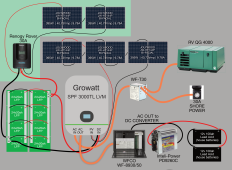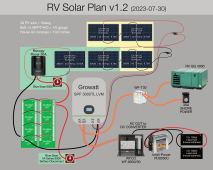Both Sunshine-eggo and I are trying to prevent your equipment from dying due to over voltage.
If you have any other questions- please ask.
Good Luck
Hugely appreciate both of your experience and brains. Thank you!
I was just looking at the specs for the GroWatt.
Max Voc 145v- danger you are over this.
Pv voltage 30-115vdc
Max PV input -4500w
(So it can handle about 39 amps of Pv input)
I see on page 43 of my
Growatt model's manual (24v version) that it is rated for 80a PV input. But if I'm misunderstanding something, please definitely correct me.
So - go 2s2p of panels into the Growatt!
Then decide what to do with the 5th panel.
This is a much more sound plan over the one I had at the beginning of this post.
Options:
get one more and go 2s3p into the growatt.
Or put the 5th panel into the 12v house battery.
A friend said I could run both sets of panels through their own respective charge controllers, and then have them each charging the single battery bank (currently the LiFePO4 24v nominal bank comprised of 8 24v20ah batteries all in parallel = 24v160ah bank). Is this a sound approach having two different charge controllers running into a single battery bank? The cells in each battery are 1C, with 3C max charge rate. Each battery is composed of 16 cells (8s2p) with a BMS in each. I'm not entirely sure what the BMS is rated for, but I can find out if it's necessary to know.
The standard 10awg Pv wires will handle 30amps (that’s what they are rated at). So 20amps through them will be no problem.
Cool.
If you decide to go 2s3p of panels- from the Pv combiner to the Growatt go with 8awg wires.
I don't think there's room to have 6 of these panels on my roof and have easy roof access; I also have 5 currently, so I'd have to match one last panel, which might be tricky. So the plan was to stick with 5.
On your drawing I don’t see fuses, breakers, or switches. From the panels to the Growatt/mppt you need a switch/breaker so you can “turn the sun off”. You also need a fuse (class T preferably) just after the battery and a switch (so you can do maintenance on the Growatt).
I just received this
Blue Sea 6006 battery disconnect switch which I intended to install between the battery and the Growatt. I have been researching 2-pole disconnects as well, but have yet to find one I feel good about. Same with fuses. If you have recommendations, I'd love some options to consider!
Label the wires with the size of wires that way we can see if a wire is under or oversized.
Great suggestion! I'll do this and update the image!
You may also want a shunt based battery monitor - that way you can know how full the lithium batteries are (and maybe one on the 12v house bank too). I love my Victron Smartshunt. I know exactly what charge level the batteries are at - helps me know if I should run the generator- or not.
Your lithium bank says 48v and 80ah (8times 24v20ah in 2s4p) - what batteries are those? With that arraignment you will need to verify they are staying in sync. Do you have Bluetooth for those batteries? Or will it be a manual process?
Good Luck
I've been looking into a shunt as well, and likely will add one soon. I'm starting to see I've one things way out of order. That said, I'm really happy to have power on board, but I definitely have pieces to make this smart and safe. I was dealing with generator CO ingress into the cabin, so I felt highly motivated to get alternate remote power working. This is meant to be an initial build that I am in the process of beefing up.
For instance, I'll probably be reconfiguring the cells from their current 8s2p configuration to something like a few batteries in an 8s16p configuration. Since these are lightly used batteries, I'm testing all of my cells (headway 3.2v 10ah). Many of them are testing above their rated power, so they're essentially brand new. I'll likely be making a few grades of them (e.g. Grade A, B, and C), then organize uniform cells into a few larger 24v batteries with BMS (including active balancing).
Again, I appreciate your questions, suggestions, and corrections. I'll update the drawing with the additional details and modified plan. Any other feedback you have, I'll definitely soak it up!







